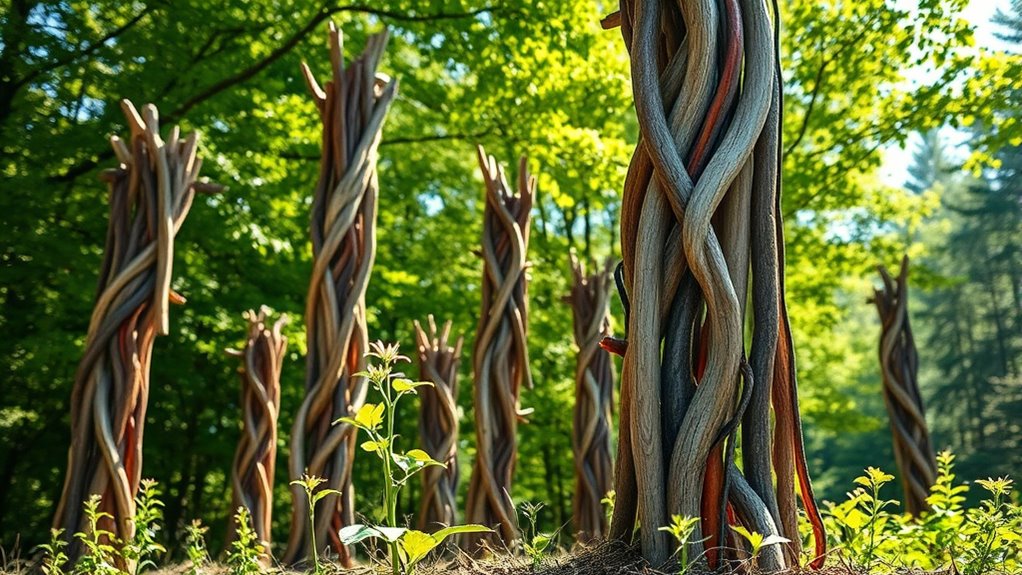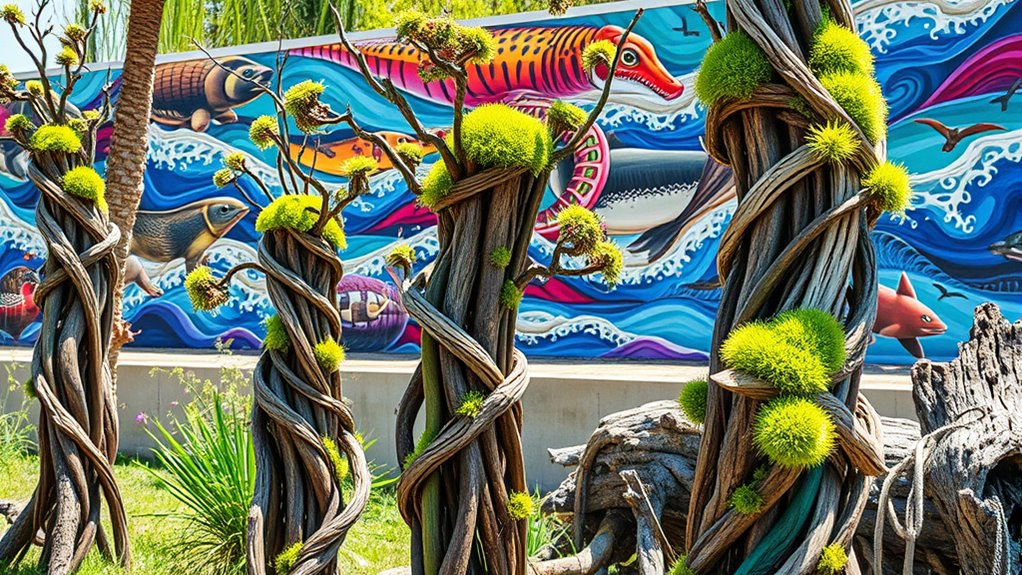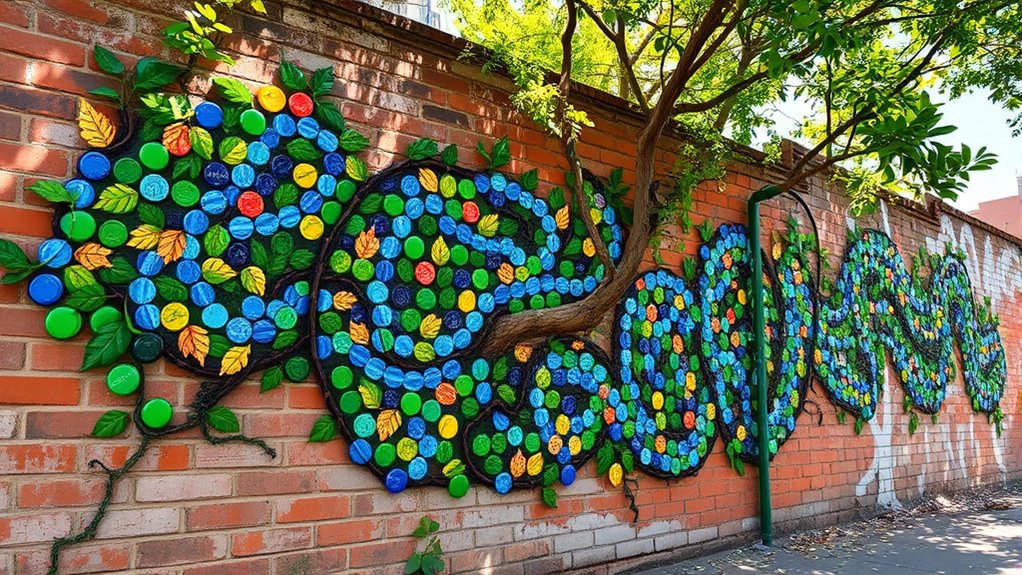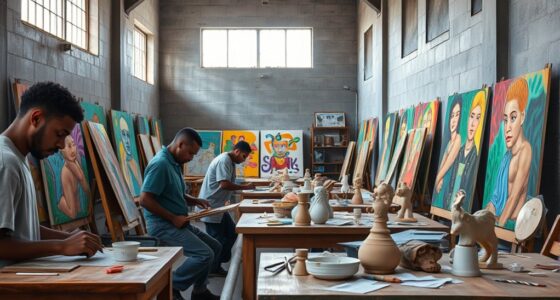Eco-art offers powerful ways to respond to environmental crises by turning ecological issues into engaging, thought-provoking experiences. Through innovative techniques, sustainable materials, and interactive practices, eco-art raises awareness and inspires action. It encourages community participation and influences policies, making ecological concerns more personal and urgent. As eco-artists explore new technologies and collaborations, their work continues to evolve. Stay tuned to discover how eco-art shapes a greener future and inspires lasting change.
Key Takeaways
- Eco-art employs recycled materials and sustainable techniques to create environmentally conscious artworks addressing ecological crises.
- It integrates natural elements and bio-art to promote ecological awareness, restoration, and harmony with nature.
- Innovative technologies, like virtual reality, enhance public engagement and deepen emotional understanding of environmental issues.
- Eco-art fosters community participation and activism, influencing societal behavior and policy toward sustainability.
- The movement emphasizes awareness, ecological responsibility, and collaboration for positive environmental change.
The Rise of Eco-Art and Its Role in Environmental Awareness

Eco-art has grown substantially since its emergence, serving as a powerful tool to raise environmental awareness. Its roots go back to the 19th century, with movements like Arts and Crafts reacting against industrial pollution and promoting traditional craftsmanship. In the mid-20th century, the environmental movement inspired artists to create large-scale earthworks, emphasizing natural fragility and harmony. During the 1960s and 1970s, eco-art gained momentum, focusing on issues like pollution and deforestation. Artists like Agnes Denes and Robert Smithson used their work to highlight environmental threats and engage the public. Eco-art’s primary role is to inspire awareness and dialogue, fostering community involvement and educating audiences about ecological challenges. It continues evolving, incorporating new mediums to deepen its impact on environmental consciousness. Advancements in technology have also enabled environmental artists to create immersive and interactive experiences that reach wider audiences globally, fostering public engagement and understanding of ecological issues. Additionally, the integration of digital media has expanded the reach and impact of eco-art initiatives worldwide.
Techniques and Materials Transforming Eco-Art Practices

Advancements in techniques and materials are revolutionizing eco-art practices by enabling you to create sustainable and environmentally integrated works. You can now incorporate recycled materials like reclaimed metal, glass, and plastics to reduce waste and resource consumption. Sourcing raw materials locally minimizes transport emissions and supports regional ecosystems. Organic elements such as soil, plants, and found natural objects deepen the connection between your art and the environment. Innovative biocomposites and biodegradable resins serve as eco-friendly substitutes for traditional plastics. You might also use upcycled textiles for large-scale installations or wearable art. Eco-friendly supplies like bamboo brushes, plant-based pigments, and water-based paints help lower chemical impacts. Energy-efficient studio practices and digital platforms further reduce your work’s carbon footprint, making sustainability integral to your creative process. Additionally, understanding the air exchange properties of your materials can help optimize insulation and preservation in eco-art installations. Incorporating sustainable materials into your work not only enhances ecological compatibility but also raises awareness about environmental issues among viewers. Exploring innovative construction techniques inspired by tiny house designs can provide fresh perspectives on eco-friendly building practices that can be integrated into your art environments. Considering My Dogs’ Names can inspire themes of loyalty and companionship within your ecological narratives, creating a more personal connection with your audience. Moreover, experimenting with biodegradable packaging can extend the eco-friendly ethos beyond the artwork itself.
Notable Eco-Art Movements and Their Cultural Significance

Emerging in the late 1960s and 1970s in America, eco-art movements like Land Art challenged traditional notions of art by integrating natural environments directly into their creations. You’ll find works created in situ, using natural materials and landscape elements, often reflecting environmental concerns. Artists like Robert Smithson with *Spiral Jetty* or Patricia Johanson’s *Leonhardt Lagoon* push boundaries by making art that interacts with and sometimes rehabilitates ecosystems. These movements emphasize collaboration with nature, highlighting impermanence, ecological responsibility, and the idea of art as a legacy. Notable offshoots include Arte Povera in Italy and site-specific art, which celebrate local context and sustainable practices. These movements expanded art’s scope, fostering awareness and inspiring activism through large-scale, community-driven projects. Environmental impact became a central consideration, encouraging artists to create works that not only raise awareness but also contribute positively to ecological restoration and sustainability efforts. Additionally, the integration of sustainable practices into art projects reflects a growing awareness of the need for environmentally conscious creativity.
Impact of Eco-Art on Society and Environmental Policy

Have you ever wondered how art can shape environmental policies and public awareness? Eco-art influences society by raising emotions and sparking action. It highlights crises like climate change and biodiversity loss, prompting policymakers and communities to respond. Art challenges dominant narratives that often ignore environmental harm and encourages new, eco-centric perspectives. You’ll see cities like Toronto fund public projects that incorporate environmental themes, making issues more visible. Community-based art engages citizens directly, fostering participation and advocacy. Eco-art’s impact includes:
Eco-art sparks public awareness, influences policies, and fosters community action on pressing environmental issues.
- Raising awareness through emotionally compelling displays
- Encouraging public involvement in environmental decision-making
- Shaping policies by highlighting urgent issues
- Challenging societal norms around growth and sustainability
- Employing cost-effective strategies to maximize outreach and engagement
- Incorporating mindfulness and self-reflection techniques to deepen emotional resonance and community connection. Additionally, integrating traditional craft techniques can create more emotionally resonant and sustainable art projects that resonate with diverse audiences, leveraging cultural heritage to strengthen community ties and sustainability efforts. Utilizing funding sources and partnerships can further amplify the reach and impact of eco-art initiatives. This dynamic interaction helps embed environmental concerns into societal discourse and policy development. Art also provides a “collective language” for interpreting crises such as climate change and social injustice, thereby fostering shared understanding and motivating collective action.
Future Perspectives: Innovations and Collaborations in Eco-Art

As technology advances, eco-art is increasingly integrating innovative tools like augmented and virtual reality to create immersive experiences that deepen public understanding of ecological issues. You can explore virtual pollution simulations or interact with ecosystems through digital exploration, fostering empathy and awareness. Artists are developing multisensory experiences by combining visuals, sound, and touch, making ecological challenges more tangible. Bio-art incorporates living materials like fungi and algae, performing ecological functions such as air purification, while biodegradable sculptures emphasize cycles of life and decay. Sustainable materials like bioplastics and recycled refuse further reduce environmental impact. The Grand Ring, recognized by Guinness World Records as the world’s largest wooden architectural structure, exemplifies sustainable design principles through modular construction that allows for dismantling, repurposing, or preservation after the Expo to minimize waste. Collaboration plays a key role, inviting communities to co-create projects through workshops and participatory events. These innovations promote environmental consciousness and demonstrate how eco-art can shape future green practices and societal change, especially when innovative materials are employed to reduce ecological footprints and support biodiversity. Additionally, understanding the importance of resources and tools can empower artists and communities to implement sustainable practices more effectively in their projects. Incorporating sustainable design principles can further enhance eco-art’s capacity to inspire lasting ecological stewardship.
Frequently Asked Questions
How Do Eco-Artists Measure the Effectiveness of Their Projects?
You measure the effectiveness of your eco-art projects by tracking community participation, gathering feedback, and observing changes in environmental behaviors. You also assess educational outcomes through surveys and project evaluations, noting increases in ecological literacy and awareness. Additionally, you consider the visual impact, cultural relevance, and media coverage. These combined metrics help you understand how well your project raises awareness, encourages action, and influences societal attitudes toward environmental issues.
What Challenges Do Eco-Artists Face When Sourcing Sustainable Materials?
Think of sourcing sustainable materials like traversing a dense forest—every step requires careful choices. You face high costs, limited availability, and the challenge of verifying claims. It’s like searching for a rare, precious plant; you must build trust with suppliers and adapt your techniques. Public perception and technical hurdles add to the journey, demanding patience, resourcefulness, and a commitment to ethical and environmentally-conscious practices.
How Can Eco-Art Be Integrated Into Formal Education Systems?
You can integrate eco-art into formal education by developing interdisciplinary curricula that connect art with science, social studies, and language arts. Use local, natural, and recycled materials for projects, making them cost-effective and environmentally friendly. Provide professional development to boost teachers’ confidence and skills. Design flexible, modular activities that fit into existing schedules, fostering place-based learning and community engagement while enhancing students’ creativity, critical thinking, and environmental awareness.
What Funding Opportunities Are Available for Eco-Art Initiatives?
You can access various funding opportunities for eco-art initiatives through government grants like the NEA’s “Grants for Arts Projects” or California Arts Council’s “Impact Projects,” which support community-based environmental art. Private foundations such as the Pollock-Krasner Foundation and Adolph and Esther Gottlieb Emergency Grant also offer financial aid. Additionally, artist residencies like Banff Centre’s programs provide resources to develop eco-focused projects, helping you bring your environmental vision to life.
How Does Eco-Art Address Cultural Differences in Environmental Activism?
You’re right to ask how eco-art bridges cultural differences. It acts as a common ground where diverse beliefs and practices meet, fostering dialogue and mutual understanding. By involving communities and honoring indigenous traditions, it turns conflicts into opportunities for collaboration. Through shared projects, you help break down barriers, showing that working together can turn tensions into harmony. Eco-art truly proves that unity in diversity can grow stronger through creative engagement.
Conclusion
As you explore eco-art, remember it’s like planting seeds of change—each piece inspires awareness and action. Just as a single drop creates ripples, your engagement can influence broader environmental conversations. Imagine an artist transforming discarded plastic into stunning murals—turning waste into wonder. Eco-art’s power lies in its ability to spark hope and drive policy shifts. By supporting and creating such work, you become part of a movement that nurtures the Earth’s future, one masterpiece at a time.









